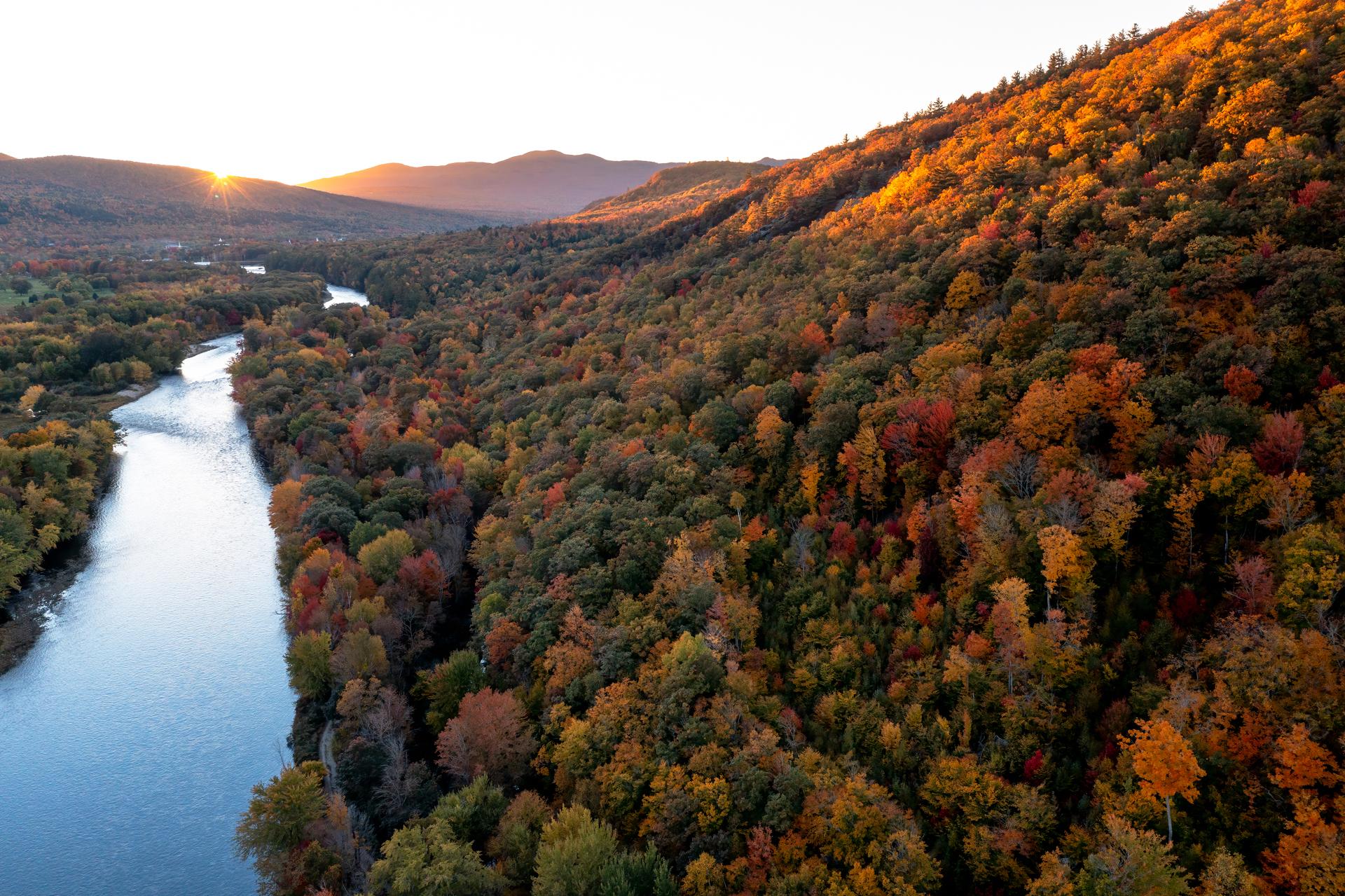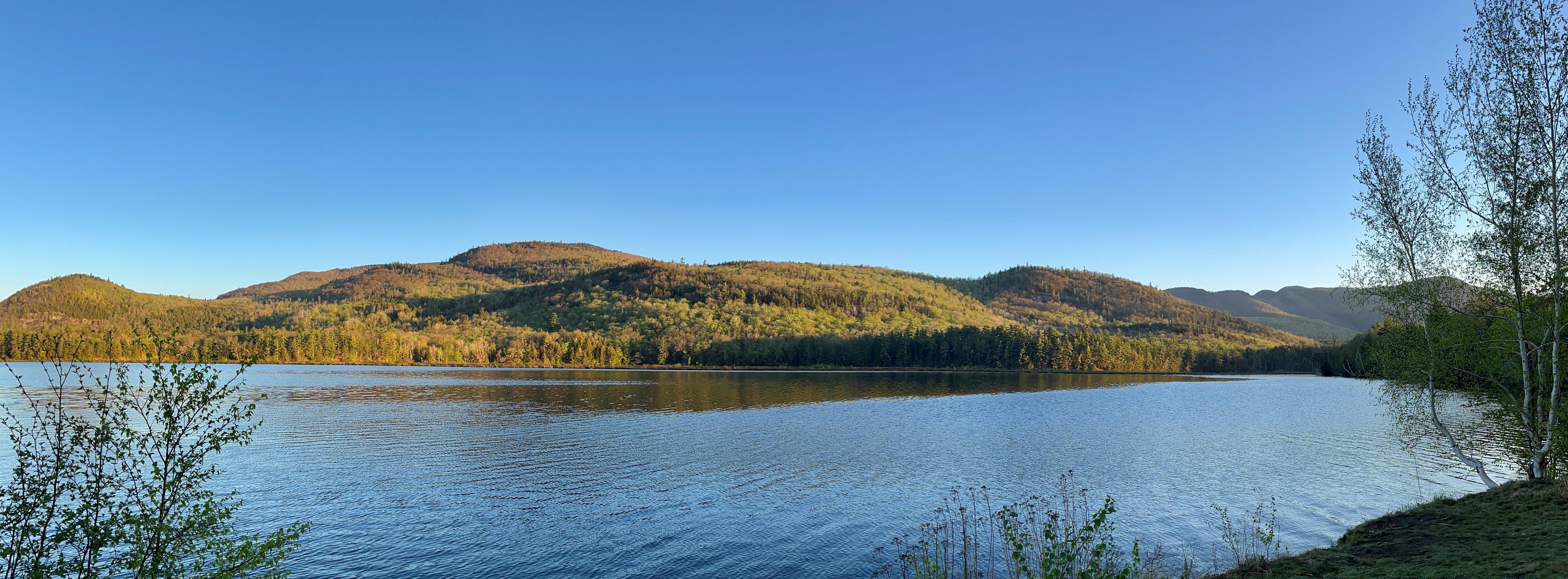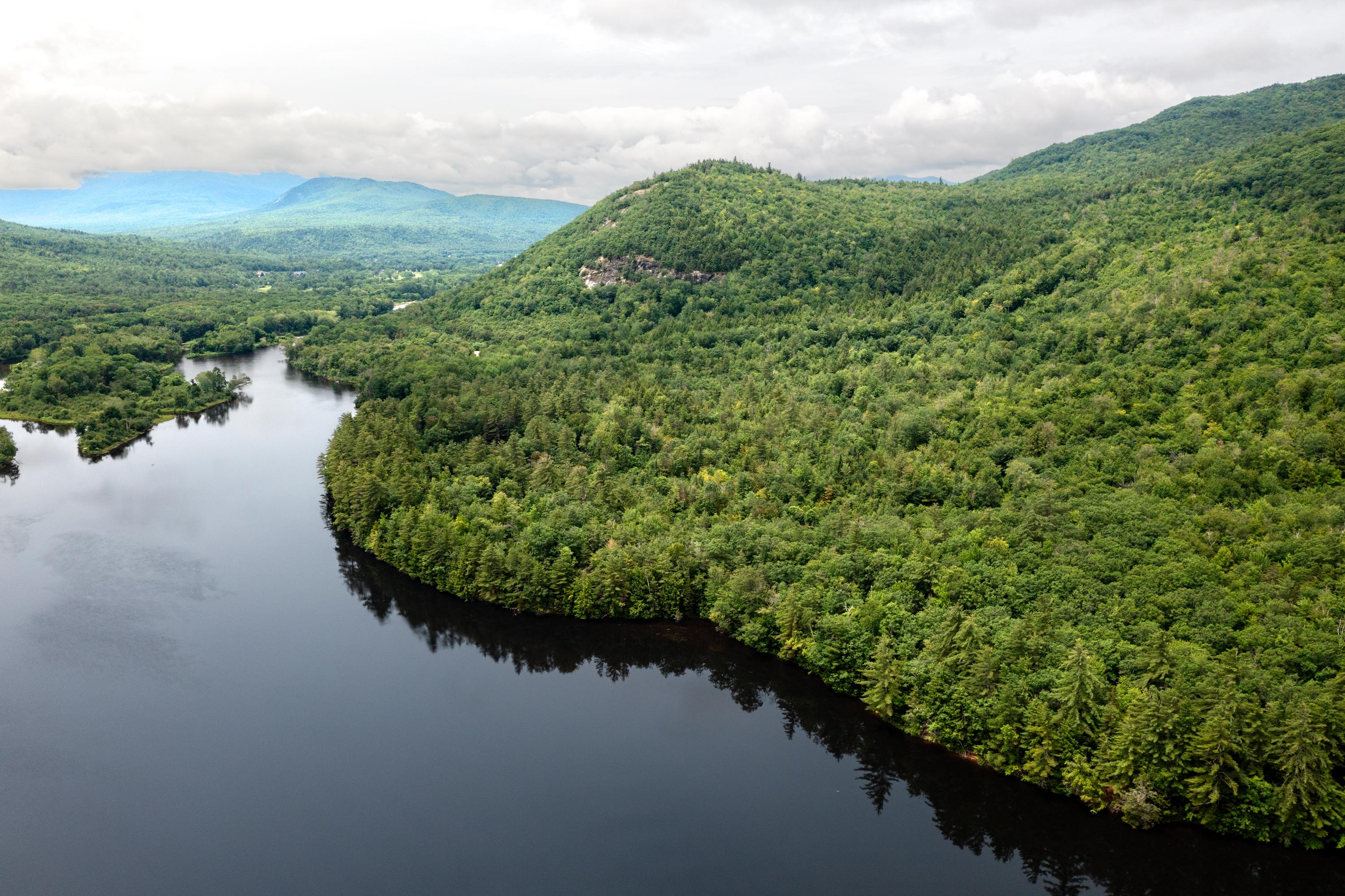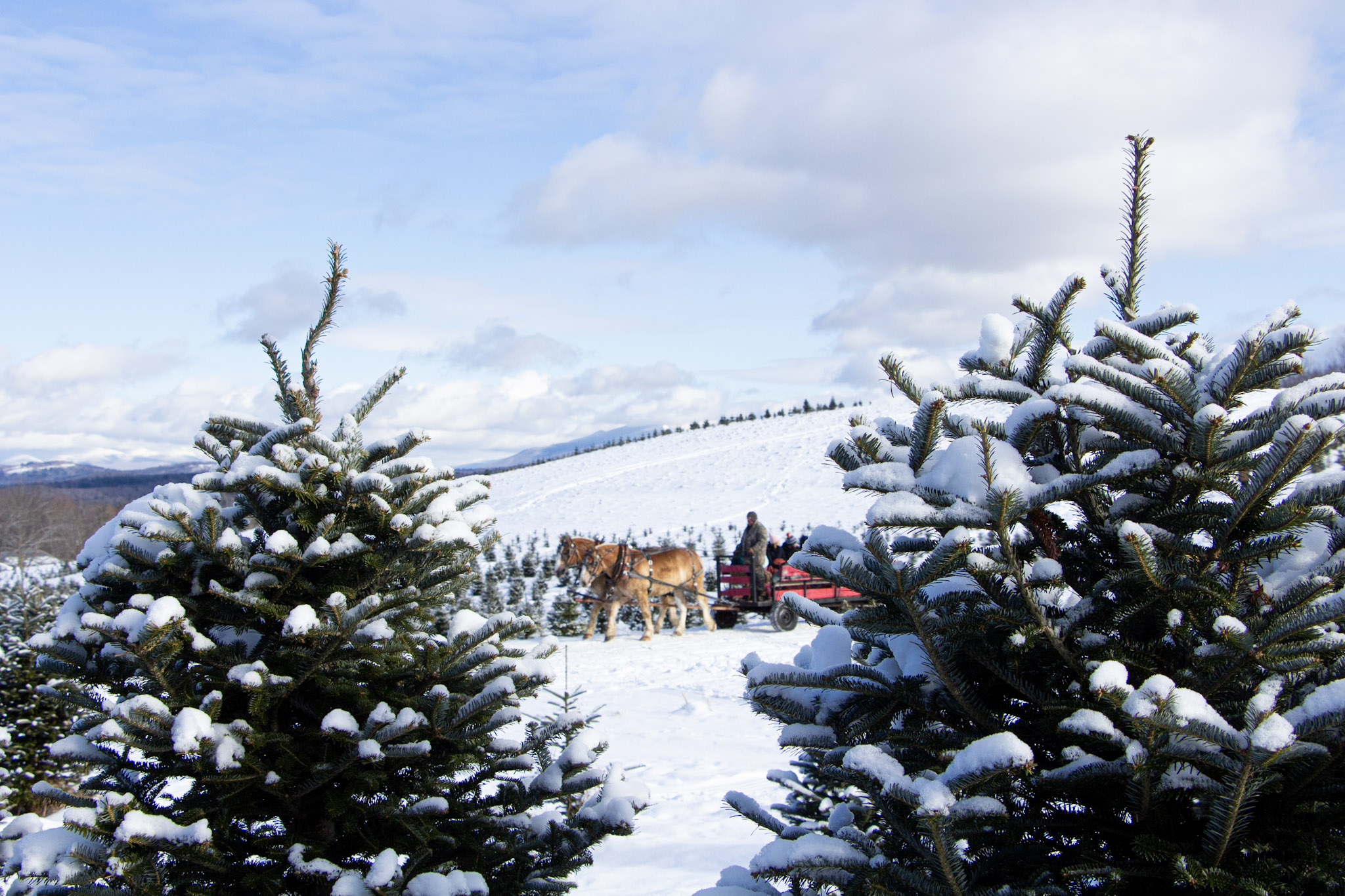From the Androscoggin River to the Mahoosuc Range, Mahoosuc Highlands Initiative Conserves 3,700 Acres
- Tags:
- Land Conservation,
- Climate

The Shelburne Valley Forest property rises from the Androscoggin River to the ridgeline of the Mahoosucs. (Photo: Ryan Smith)
SHELBURNE, NH —The Society for the Protection of New Hampshire Forests (Forest Society) completed the permanent protection of the 2,670-acre Shelburne Valley Forest and 1,030-acre Bald Cap Peak Forest, known collectively as the Mahoosuc Highlands Initiative. Rising from the valley floor of the Androscoggin River and reaching the narrow spine of the Mahoosucs mountains and the Appalachian Trail, the Shelburne Valley and Bald Cap Peak Forests present spectacular views to travelers along Route 2 in Shelburne, a view that exemplifies the rugged beauty of New Hampshire’s North Country.
The Forest Society partnered with The Conservation Fund and the Town of Shelburne’s Conservation Commission to conserve these forest lands. That partnership was key to the success of these conservation projects and mark the beginning of a long-term cooperative relationship to care for these lands over many years to come.
“These 3,700 acres are a remarkable addition to our constellation of nearly 200 forest reservations statewide,” said Jack Savage, president of the Forest Society. “This project is a prime example of our conservation goals north of the notches: conserving working forest that provides sustainable forest products, enhances outdoor recreation, protects water quality, and links diverse ecosystems that combat climate change. I want to thank our partners and donors who helped make it possible. The Mahoosuc Highlands Initiative is another significant achievement in a multi-decade partnership between local, state, and national organizations to protect a connective corridor of forest in the Upper Androscoggin Valley.”
Conserving the Shelburne Valley Forest property has long been a priority for the Shelburne Conservation Commission.
“We are delighted that the Mahoosuc Highlands project meets many of the values and goals developed in Shelburne’s master plan, including preservation of open space and protection of the Androscoggin River,” states Conservation Commission Chair Katie Stuart.
“This project is important and compelling because in addition to connecting wildlife habitat on conserved lands between the Mahoosuc and the Carter-Moriah mountains, it preserves traditional public recreational access along Hogan Road, beloved by residents and visitors to our part of northern New Hampshire. We are grateful to the Forest Society, the Mahoosuc Land Trust, and The Conservation Fund for partnering with our town to conserve land and maintain recreational opportunities for our many constituents. The Forest Society will lead, guide, and collaborate with a local advisory committee and other stakeholders to develop a management plan for the land. The acquisition will protect a significant ecological, recreational, and economic resource for the Androscoggin Valley that will benefit us now and for future generations.”

The Shelburne Valley Forest property rises from the Androscoggin River to the ridgeline of the Mahoosucs. With 24.3 miles of stream frontage and the headwaters of the Leadmine Brook, the property supports critical cold water stream habitats for wild brook trout, a New Hampshire Species of Greatest Conservation Need. The property consists of diverse riverine habitats, including cranberry bogs, red spruce swamps, silver maple floodplain forests, as well as talus slopes and cliffs helping to support a healthy black bear population. A local recreational resource, the project includes the Cross NH Adventure Trail (an increasingly popular 84-mile bike-packing trail that traverses northern New Hampshire), 1.6 miles of frontage on the Androscoggin River for fishing and boating and provides a protective buffer for the Appalachian Trail (AT).
The Bald Cap Peak Forest was acquired by the Forest Society in fee from The Conservation Fund. The Conservation Fund pre-acquired the land at the request of residents supporting public access and forestland use and the National Park Service (NPS) to expand the buffer along the Appalachian Trail (AT).
“The Mahoosuc Highlands has been protected in perpetuity thanks to a powerful partnership between The Conservation Fund, Mahoosuc Land Trust, the Town of Shelburne Conservation Commission and the Forest Society,” said Sally Manikian, New Hampshire and Vermont Representative of The Conservation Fund. “For nearly 20 years, The Conservation Fund has worked in the Androscoggin Valley, going where needed and requested to ensure access to working lands for hunting, fishing, hiking, biking, and more. As a local resident, I’m eager to set foot on the Mahoosuc Highlands and look forward to seeing you all out there.”
Bald Cap Peak Forest directly abuts the Forest Society’s Peabody Forest. The property is home to the beloved and historic hiking trails of Peabody Brook, Middle Mountain, Giant Falls, and Bald Cap Peak. The rocky pine ledges of Bald Cap and Middle Mountain, and the 300-foot cascades of Giant Falls, are prominent features of the property and were recently featured in the Boston Globe. With 2.6 miles of boundary with the AT, the parcel supports a connective corridor between the Mahoosucs and the White Mountain National Forest and builds on existing conserved lands in Shelburne held by the Mahoosuc Land Trust and New Hampshire Fish and Game.

Many local, state, national organizations, and funding programs came together to help facilitate and fund the acquisition and conservation of these lands. The New Hampshire Land and Community Heritage Investment Program (LCHIP) provided $500,000 to help conserve the Shelburne Valley Forest, and $400,000 to conserve the Bald Cap Peak Forest.
“The North Country’s growing outdoor-recreation economy is dependent on access to back-country land for recreation. Together these two forests secure that access, while also preserving critical habitat, protecting aquatic resources, and supporting working forestland,” said Land and Community Heritage Investment Program executive director Paula Bellemore. “The Mahoosuc Highlands Initiative checks every box for LCHIP, and we are pleased to have played a role in securing these expansive forests for conservation and recreation.”
The New Hampshire Department of Transportation and the New Hampshire Department of Environmental Services, through the Aquatic Resources Mitigation Fund’s In-lieu Fee Program, worked together to provide a mitigation payment worth more than $1.2 million dollars for the Shelburne Valley Project.
“The Department is very pleased that the project’s wetland mitigation funds are being used to preserve the Shelburne Valley Forest for us all to enjoy,” states Timothy Dunn, project manager for the New Hampshire Department of Transportation.
“Locating a mitigation site within the same watershed as a project is rare and even rarer still that the timing works out to be able to use those funds,” adds Dunn. “The Department’s wetland mitigation fee is required compensatory mitigation for damage to wetlands caused by an upcoming project on NH Route 16 in Cambridge that will reconstruct the road and move it away from the Androscoggin River.
"We believe this mitigation is a win-win for all involved, the public gets both an upgraded road that is safer and better protected from the river, and a new protected forest straddling the Appalachian Trail. I want to thank all our partners in this effort, the NH Department of Environmental Services, the Federal Highway Administration, and the Forest Society for working through the hurdles with us to get this mitigation across the finish line.”
An additional grant awarded to the Shelburne Valley Forest project was provided by the U.S. Forest Service Community Forest Program. The federal funding is aimed at conserving land in communities that provide direct benefits to the communities.
“The Forest Service is honored to help protect these diverse and important lands through the Community Forest and Open Space Conservation Program. Keeping forests as forests provides a unique opportunity to ensure public access, recreational opportunities, protect vital water supplies and critical wildlife habitat,” said Regional Forester Gina Owens.
The Mahoosuc Land Trust (MLT) also played a critical role in accepting the conveyance of a conservation easement on the Shelburne Valley Forest property required by one of the project funders. The conservation easement on the 2,670-acre Shelburne Valley Forest abuts MLT’s 880-acre Shelburne Riverlands preserve which protects numerous islands and riverine habitat along the Androscoggin River.
“Mahoosuc Land Trust is thrilled to support the Forest Society’s acquisition which will ensure permanent, sustainable management of these lands, which have seen multiple ownership changes in the past three decades,” said MLT Executive Director, Kirk Siegel. “This project complements many years of conservation work by MLT and others that recognize the significance of the Mahoosuc Mountains as a nationally significant resource in both New Hampshire and Maine.”
Additional funding was also provided by several private foundations including the New Hampshire Charitable Foundation’s Randolph Area Conservation Opportunity Fund, the Appalachian Trail Conservancy’s Wild East Action Fund, and over 160 individual private donors
The combined project protects more than 3,700 acres. Both properties are now owned by the Forest Society as a permanently protected forest reservation. The lands will be managed for their long-term, multiple use objectives, including forest management, habitat protection, scenic value, and for public recreation and education. The lands will remain open to hiking, hunting, fishing and for future forest management.
“The Shelburne Valley Forest protects a significant ecological, economic, and recreational resource for the region,” states Brian Hotz, vice president of land conservation at the Forest Society. “We are thrilled to be seeing this project through to completion.”
#####
